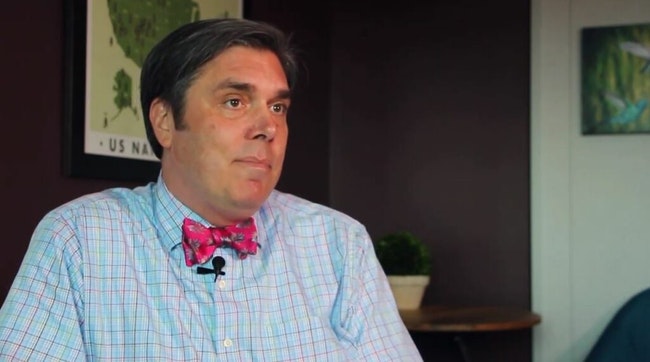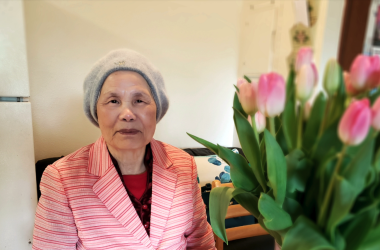
Dr. Dean Sidelinger was hired as Oregon’s state health officer and epidemiologist in September 2019.(YouTube video)
At 50, there’s a lot that Dr. Dean Sidelinger could brag about.
He earned a doctor of medicine degree from a highly ranked university and added a master’s in education. As a pediatrician, he trained younger physicians and helped shape medical curricula.
Then he went into public health.
For nearly 15 years as a health leader, he’s confronted multiple outbreaks. He guided San Diego County through the deadly swine flu outbreak in 2009 and now plays a key role in Oregon’s fight against COVID-19 as the state health officer and epidemiologist.
He’s often the public face of the pandemic in news conferences, calmly and resolutely urging Oregonians to protect themselves.
Behind the scenes, he serves as the state’s chief medical adviser.
But when asked about his accomplishments in a recent interview with the Oregon Capital Chronicle, he deflected the conversation toward his team, a word he used several times.
“He’s really just a team player,” said Dr. Gregory Blaschke, Sidelinger’s longtime partner and head of general pediatrics at Oregon Health & Science University. “He sort of undersells himself.”
Sidelinger would prefer to remain in the background. But his job often calls for him to be on center stage, tirelessly repeating the same public health messages about the need to get vaccinated and wear masks.
Since the pandemic hit in early 2020, he’s worked 10 hours a day, if not longer, at least six days a week remotely or out of his office in Northeast Portland.
“He’s there morning to night and at so many different meetings,” said Rachael Banks, Oregon’s public health director and Sidelinger’s boss. “He’s really responsive no matter how late or how tired he is.”
He doesn’t just work on COVID-19.
“The range of topics that Dean provides an influence on is broad across the public health system,” Banks said.
When he stepped into the job in September 2019, he didn’t expect to spend nearly two years grappling with the worst health crisis in modern times. He thought he’d be implementing Oregon’s five-year public health improvement plan.
The state plan focuses on what health officials call the social determinants of health, factors like limited access to mental health care, social inequities and a lack of affordable housing that play a large role in shaping health status.
He was keen to work on that challenging task, drawing on his experience as a public health leader in California’s San Diego County, home to about 3.5 million people. There, he dealt with issues from tobacco use and maternal health to obesity. He had experience with community health and curtailing health inequities by improving access for everyone, regardless of their ethnicity or race.
But then COVID-19 hit, and it consumed his life.
The daily case count of infected Oregonians, which peaked in August, and the relentless death toll, which now includes younger lives, has weighed on Sidelinger.
Every weekday morning, he reads the death certificates, reflecting on the lives lost.
Every night, he sleeps fitfully, often torn awake by worry.
He wonders if he could have done more to save more lives or what health officials should do differently.
After 15 months of tracking the spread, trying to get Oregonians vaccinated and keep people safe, he got a reprieve from the pandemic this May when he spent four nights in Cabo San Lucas in Mexico with his husband.
“That was the first time he slept through the night,” Blaschke said.
 Dean Sidelinger in his home office. (Dean Sidelinger photo)
Dean Sidelinger in his home office. (Dean Sidelinger photo)
Sidelinger grew up in Bristol, Conn., southwest of Hartford. He was the baby of the family, with an older brother and two older sisters. They had a half-sister from his father’s first marriage.
Sidelinger was 4 when his family moved to Mexico City, where his dad worked with power companies. His siblings went to an English-speaking school but he was too young. The first few weeks he hung out with Marcella, the Spanish-speaking maid, and then went to nursery school. He quickly learned Spanish and still speaks it today.
When he was 7, the family moved to Caracas, Venezuela, for two years before returning to Bristol.
Sidelinger was a reader. When he got too old for Richard Scarry as a child, he turned to The Three Investigators detective series. Today, he still enjoys mysteries to get a break from his job. He also swam, though never competitively, and played tennis. He was a good student but his sister Lynn Curry, who now lives in North Carolina, doesn’t remember him studying much.
“He was just naturally smart, to be honest,” Curry said. “He also did a lot of after-school activities.”
He was in the chorus at Bristol Eastern High School and joined the National Honor Society. He also performed community service, in line with his mother’s emphasis on being respectful and helping others.
Sidelinger was outgoing and easily made friends.
“He can have a conversation with anyone, and he could even do that when he was a teenager,” Curry said. “He’s interested in what everyone has to say. I admire that about him.”
That trait has been an asset in his career.
“We all knew he was going to be the one who was the most successful,” said his oldest sister Sandi Murray, who lives in Bristol.
Though school work and friendship came easily, Sidelinger also faced challenges growing up. In high school he was diagnosed with soft tissue sarcoma that caused his big right toe to swell. It was amputated, and he has been cancer-free ever since.
As a cancer survivor in medical school, he thought he would become an oncologist. But another childhood influence won out.
“My mom said I often spoke highly about my pediatrician, Dr. Byrd,” Sidelinger said.
Medical training in the South
His family was impressed when he got into Georgetown University in Washington D.C. out of high school. He earned a bachelor’s in chemistry and a medical degree, then moved to Memphis for his residency at the University of Tennessee.
He bonded with other residents who didn’t have ties to the area. He enjoyed the community and the food but the segregation and racism came as a shock. He had never been exposed to that so overtly before.
The rotations included treating young cancer patients at St. Jude Children’s Research Hospital in Memphis. That experience doused his dream of being an oncologist.
“Though we’ve made great strides with pediatric cancer, there’s still a lot of tragic outcomes,” Sidelinger said. “I don’t think I was set up for that.”
But he did enjoy pediatrics. Unlike adults, who can be cranky when they get better, children are easy. They ask for French fries and want to play.
Sidelinger also appreciated the relationships with families. Parents marveled over their child’s first words and fretted about rough patches during adolescence. He enjoyed helping them navigate through it all.
After his residency, Sidelinger moved to San Diego for a fellowship in community pediatrics at the University of California. He saw patients in a clinic and worked in urgent care. When the fellowship ended after three years, he remained as a faculty member.
At the university, he earned a master’s degree in education.
He also met the man of his life.
Blaschke was a U.S. Navy pediatrician who had contact with university faculty. The pair collaborated on two research papers about the need for cultural awareness in treatment and training pediatricians outside a hospital setting.
They were interested in helping underserved communities and had an interest in public health. Sidelinger wanted to help to improve public health by working on issues in society.
“He’s a lot about community – the big picture,” Blaschke said.
About a year after they met they moved in together.
County creates job
Sidelinger left the university to become the deputy public health officer in the county’s Health and Human Services Department where he worked on the county’s health plan and grappled with outbreaks. San Diego was ground zero for the H1N1 or swine flu pandemic, with the first U.S. case diagnosed there in 2009. About 60 people in San Diego died.
The job gave Sidelinger experience talking to the media.
“He has a great way of boiling things down and keeping it short and succinct and right on target,” said Dr. Eric McDonald, chief medical officer of San Diego County.
In 2009, Blaschke retired from his 21-year-long career in the U.S. Navy and took the job at OHSU. He chose OHSU in part because of Portland, where they enjoyed the walkable neighborhoods, restaurants and focus on local businesses.
Blaschke moved to Portland, and Sidelinger planned to follow.
“We decided we could do another one or two years, and I would commute,” Sidelinger said.
He remained as San Diego’s interim deputy health officer for two more years, then quit and moved to Portland in 2011.
But he was missed.
Sidelinger was bright, adept at cross-disciplinary work and had a knack for bringing people together and shepherding them to their goal. His former boss wanted him back.
“My agency director, Nick Macchione, was not happy to lose him,” McDonald said, “and he knew (Sidelinger) wanted to keep his hand in public health.”
The county created a job for Sidelinger as chief of children’s health.
He tackled improving access to depression treatment for mothers and preventive dental and health treatment for children. He also faced successive whooping cough outbreaks. They were more severe than anywhere else in California.
Back in Portland on the weekends, Sidelinger enjoyed family life.
In 2017, he and Blaschke married. They figured they should make it official with Donald Trump thick in his presidential campaign and while they still had a parent alive — Blaschke’s mother. So, they bought matching Aloha shirts and held a ceremony on a beach in Hawaii.
The couple lives in a three-story 1906 house in Northwest Portland that’s filled with art. The house has a chef’s kitchen, with a clutter of hanging pans, and plenty of space for clothes.
Sidelinger and Blaschke own about 400 bow ties. Sidelinger is partial to floral prints, especially Liberty London designs. He also has a big collection of colorful, patterned socks and owns about 200 pairs of shoes, including by John Fluevog, Canadian designer, and MOMA, an Italian brand.
“He’s basically decked out from his neck to his feet,” said Banks, public health director, marveling that Sidelinger manages to blend various colors and patterns together.
His dapper demeanor is matched by a quick wit, she said.
“He’s quite funny,” Banks said. “Very witty.”
Sidelinger is also a consummate host. When family visits, each person gets shampoo in their bedroom and chocolate on their pillow with sentimental meaning. In the evening, he whips up dinners from Ina Garten and mixes drinks. He enjoys a good Negroni or a Manhattan and has learned to appreciate Scotch during the pandemic.
“He is quite the cook,” McDonald said. “He introduced me to the fact that there is more than one kind of bitters to mix cocktails with.”
In May 2019, a good job opened up in Portland. Dr. Katrina Hedberg retired, staying through the summer to help find her replacement. Sidelinger got the job in September.
By that December, the first report emerged about the coronavirus outbreak in China.
Sidelinger hoped the virus might follow the pattern of a coronavirus outbreak that started in late 2002. It was deadly, killing about 800 people worldwide, but contained in about eight months.
The first cases of the virus that causes COVID-19 emerged in the U.S. in January 2020, and a month later, Oregon confirmed the first Oregonian with the coronavirus. Sidelinger was faced with his greatest professional challenge as the virus gripped the state, with schools and businesses closing and a mounting death toll.
Sidelinger told the Portland Business Journal last August that the state could have handled the pandemic better by testing for COVID-19 more quickly and broadly.
But in a recent interview with the Oregon Capital Chronicle, he stressed the positive.
“I’m proud of our overall response in Oregon,” Sidelinger said. “We made recommendations and the governor acted early.”
For months, Oregon appeared to have skirted the worst of the pandemic, with neighboring states and much of the country hit harder. That changed when the delta variant emerged, throwing the state’s hospitals into a crisis, with intensive care units full and physicians forced to delay necessary surgeries.
Deaths have surged past 3,600 and included an infant.
“We’re in the midst of our darkest hour, with a high surge right now,” Sidelinger said. “But our overall cumulative case rates and death rates have been among the lowest. So we truly have saved thousands of lives through the recommendations and the policies we have in place.”
 Dean Sidelinger with his niece Jessica Murray in 2012. (Sandi Murray photo)
Dean Sidelinger with his niece Jessica Murray in 2012. (Sandi Murray photo)
Like many state workers, Sidelinger now solely works from home. He spends hours on his laptop, pen and paper close, in an office decorated with cheerful paintings, including a whimsical print by Spanish painter Joan Miro.
While supervising five people, Sidelinger works with other senior health advisers.
One is Cara Biddlecom, deputy public health director and policy and partnerships director. She’s quick to praise Sidelinger.
“The folks working with him every day love him and love working with him,” Biddlecom said. “I miss seeing him in the office every day.”
She, too, remarked on Sidelinger’s thoughtfulness. In meetings early on, when staff members were cooped up in the Portland office for 14 or more hours a day, he often brought chocolate, she said.
“That’s something that I’ve appreciated,” Biddlecom said, noting that it’s rare for public officials to be so caring.
In a video before Labor Day, Sidelinger shared his morning ritual of reading the death certificates. He repeated that in an online news conference, too.
But the public has not always responded in kind. Sidelinger has received hate mail, including some he reported to police.
One man even drops off notes and literature in his mailbox. Sidelinger didn’t go into detail, saying law enforcement has followed up. The house is equipped with a security system.
“It is a sad time that many public health professionals across the country have had to deal with these threats,” Sidelinger wrote in a text message.
Sidelinger sometimes gets angry at the vaccine skepticism in Oregon that keeps people from protecting themselves against the virus.
“It can be frustrating, but we have to figure out how to combat the misinformation that led to that decision,” Sidelinger said. “Are they not vaccinated because they don’t trust the system? And if so, who in their community do they trust?”
He added: “Gone are the days where we can put out a sign on the sidewalk and say COVID vaccines and people will line up,” Sidelinger said.
Despite the challenges, Sidelinger said that his team “really has come together and grown stronger as we’ve responded to every twist and turn the virus has thrown at us.”
In a rare escape from the relentless pressure, Sidelinger recently embarked on a three-week vacation to Scotland.
He knows the pandemic awaits him when he returns. He expects the virus to rage through the winter and perhaps linger to next summer though the picture could change if a new variant emerges that is able to defeat the vaccines.
Yet he’s optimistic.
“I hope that a year from now we’re having a very different conversation,” Sidelinger said. “I have to be humble. Predicting the future is going to be hard. But I do think signs are pointing in the right direction.”
Oregon Capital Chronicle is part of States Newsroom, a network of news bureaus supported by grants and a coalition of donors as a 501c(3) public charity. Oregon Capital Chronicle maintains editorial independence. Contact Editor Les Zaitz for questions: [email protected]. Follow Oregon Capital Chronicle on Facebook and Twitter.
NEWS TIP? Please send an email to [email protected] for our reporters to consider.









